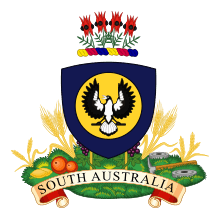South Australian House of Assembly
| House of Assembly | |
|---|---|
 | |
| Type | |
| Type | |
| History | |
| Founded | 1857 |
| Leadership | |
| Structure | |
| Seats | 47 |
 | |
Political groups |
Government Labor (24) Opposition Liberal (21) Crossbench Independent (2) |
| Meeting place | |
|
| |
|
House of Assembly Chamber, Parliament House, Adelaide, South Australia, Australia | |
| Website | |
| SA House of Assembly | |
The House of Assembly, or lower house, is one of the two chambers of the Parliament of South Australia. The other is the Legislative Council. It sits in Parliament House in the state capital, Adelaide. The fourth-term South Australian Branch of the Australian Labor Party has been in government since the 2002 election.
The 47-seat house consists of 24 Labor, 21 Liberal and 2 independents, Geoff Brock and Martin Hamilton-Smith. Following the 2014 election, the lower house consisted of 23 Labor, 22 Liberal and 2 independents, Geoff Brock and Bob Such. Hamilton-Smith became an independent shortly after the election, reducing the Liberals to 21 seats. Both Hamilton-Smith and fellow independent Geoff Brock are in cabinet and provide confidence and supply while retaining the right to vote on conscience. Labor went from minority to majority government when Nat Cook won the 2014 Fisher by-election which was triggered by the death of Bob Such. Despite this, the Jay Weatherill Labor government kept crossbench MPs Brock and Hamilton-Smith in cabinet, giving the government a 26 to 21 parliamentary majority.[1]
Overview
The House of Assembly was created in 1857, when South Australia attained self-government. The development of an elected legislature — although only men could vote — marked a significant change from the prior system, where legislative power was in the hands of the Governor and the Legislative Council, which was appointed by the Governor.
In 1895, the House of Assembly granted women the right to vote – the second place in the world to do so after New Zealand in 1893 – and the first to allow women to stand for election.[2]
The House of Assembly has had 47 members since the 1970 election, each coming from a single-member constituency: currently 34 in the Adelaide metropolitan area and 13 in rural areas. These are commonly known as seats, and are intended to represent approximately the same population in each electorate. Voting is by preferential voting with complete preference allocation, as with the equivalent federal chamber, the Australian House of Representatives. All members face re-election approximately every four years. The most recent election was held on 15 March 2014.
Most legislation is initiated in the House of Assembly. The party or coalition with a majority of seats in the lower house is invited by the Governor to form government. The leader of that party becomes Premier of South Australia, and their senior colleagues become ministers responsible for various portfolios. As Australian MPs almost always vote along party lines, almost all legislation introduced by the governing party will pass through the House of Assembly.
As with the federal parliament and Australian other states and territories, voting in the Assembly is compulsory for all those over the age of 18. Voting in the House of Assembly had originally been voluntary, but this was changed in 1942.
While South Australia's total population is 1.7 million, Adelaide's population is 1.3 million − uniquely, over 75% of the state's population resides in the metropolitan area and has 72% of seats (34 of 47) alongside a lack of comparatively-sized rural population centres, therefore the metropolitan area tends to decide election outcomes. At the 2014 election for example, although the state-wide two-party vote (2PP) was 47.0% Labor v 53.0% Liberal, the metropolitan area recorded a 2PP of 51.5% Labor v 48.5% Liberal.[3]
Election result summaries

Current distribution of seats
| Party | Seats held | |
|---|---|---|
| 2014 | 2014–current | |
| Australian Labor Party | 24 | |
| Liberal Party of Australia | 21 | |
| Independents | 2 | |
- 24 votes as a majority are required to pass legislation.
See also
- List of elections in South Australia
- List of South Australian state by-elections
- Members of the South Australian House of Assembly
- Parliaments of the Australian states and territories
- South Australian Electoral Districts (for the House of Assembly)
References
- ↑ Fisher by-election win for Labor gives Weatherill Government majority in SA: ABC 13 December 2014
- ↑ Women’s Suffrage Petition 1894: parliament.sa.gov.au
- ↑ Metropolitan 2PP correctly calculated by adding raw metro 2PP vote numbers from the 34 metro seats, both Labor and Liberal, then dividing Labor's raw metro 2PP vote from the total, which revealed a Labor metropolitan 2PP of 51.54%. Obtained raw metro 2PP vote numbers from ECSA 2014 election statistics, ECSA 2014 Heysen election and ABC 2014 Fisher by-election.